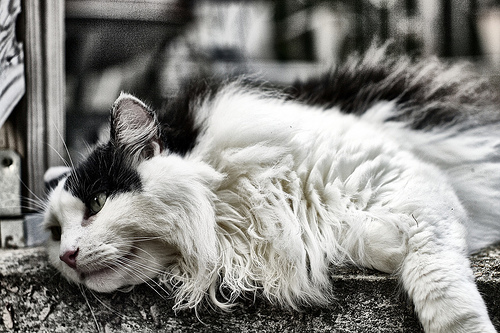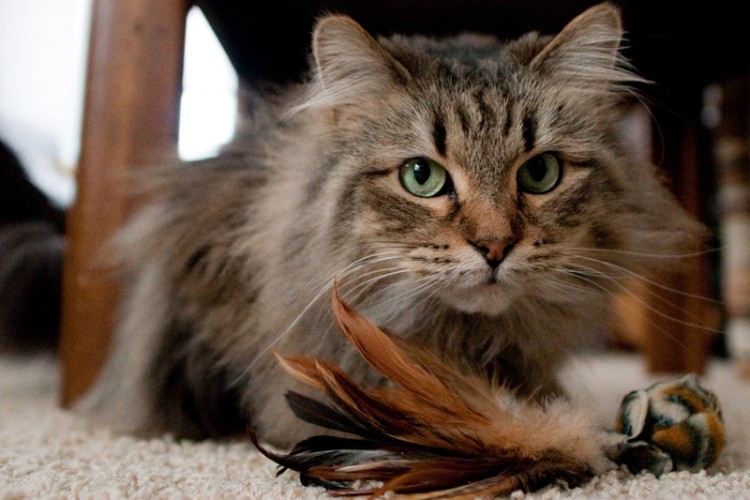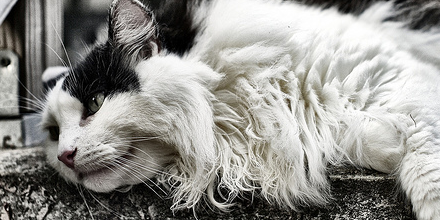This article was written by veterinarians Dr. Debora Lichtenberg, VMD, and Dr. Pippa Elliott, BVMS, MRCVS, as well as contributing writer Kristine Lacoste. It was originally published in 2015. This article was reviewed for accuracy by Dr. Elliott and was last updated on May 28, 2024
If you have questions or concerns, call your vet, who is best equipped to ensure the health and well-being of your pet. This article is for informational purposes only and is not a substitute for professional medical advice, diagnosis or treatment. See additional information.

We received this question from a reader, who wanted to know how to remove matted cat hair specifically from a longhaired cat:
“I was wondering if you have any advice on removing my longhaired cat’s mats on her back. They are hard, and she is very overweight so she can’t clean her butt either. I was going to find her another home, but no takers. I have decided to cut the hair clumps out.” —Libby
Hi Libby, and thanks for your question. Please don’t reach for the scissors yet.
Removing mats from your pet should not result in an emergency vet visit. But does this happen? You bet.
Many well-meaning people just want to take that pesky mat off their cat or dog, but they’re actually performing unwanted surgery. Then actual surgery by a veterinarian is needed to close the laceration created by them.
So taking a pair of scissors to your pet’s body is never a good idea. Sometimes it winds up as a mini–Texas Chainsaw incident.
In this article, you will learn several options you can try at home if you want to know how to remove mats from a longhaired cat.
Causes of Matted Cat Hair
Matted fur is a condition that occurs mostly in longhaired cats when their fur becomes knotted and entangled. There are several reasons this can happen. When a cat sheds their undercoat, the fur can become caught in the top coat. If a cat’s fur becomes dirty or oily, it can also become entwined and matted. Matting can also occur in places on the cat’s body that involve a lot of movement such as between the legs, under the chest, and around the collar. The longer matted fur is left unattended, the more problematic it becomes, as the knots will grow tighter and cause discomfort and possibly health issues for your cat.
You might notice an odor coming from your cat and consider bath time, but giving your cat a bath can actually make mats worse.
Factors Contributing to Matted Cat Hair
- Overweight, old, or sick cats can have a hard time reaching all areas of their bodies for grooming.
- When animals don’t feel well, they stop grooming. They could be in pain from dental problems or arthritis, or they could have nausea.
- Indoor-only and shorthaired cats can also get mats from a buildup of dust and dander.
- See our related article for much more about the causes of matted hair in cats.
How to Remove Matted Cat Hair
Keep the Hair Dry
Adding water to your cat’s fur can make the mat set even tighter.
Pet groomers recommend a detangler or anti-static spray, but most mats can be removed without these products.
We have seen people recommend children’s detangler spray or talc-free powder, but use only products that are intended for your animal.
When you reach for products you keep at home, you could accidentally use something containing ingredients that are toxic to your cat, and it’s just not worth the risk.

Using a Wide-Toothed Comb
Regular brushing is recommended for your cat’s coat health, and most knots and mats can be removed this way.
- When you reach a mat, hold the fur closest to the skin with your fingers before brushing or pulling at the mat. This helps control the resistance from your brushing and avoids pulling on the cat’s skin.
- Start at the end of the mat and work your way up. This helps prevent the pain of the brush getting stuck.
- If your cat has a thick undercoat, try an undercoat comb. It has 2 sets of teeth at different lengths, which may work better.
Watch this quick video from a professional pet stylist, then we’ll discuss another method:
Using a Mat Comb
If regular brushing or using the wide-toothed comb doesn’t work, there is another brush called a mat comb, sometimes called a razor comb. This is a brush with recessed blades that will cut the hair as you brush.
- It’s particularly helpful if you can get under the mat. Just remember to hold the base of the cat’s fur and skin to reduce pain and pulling.
Using Clippers
If all these methods are still unsuccessful, you can use an electric razor (clippers) to cut the mats out. We recommend that you get a groomer to do this.
- Make sure the skin is flat and tight as you use the razor, or else you might cut or tear the skin.
- A cat’s skin is thin and sensitive to the heat that clippers can create. So press the tool against your arm to make sure it is not warm before using it on the cat — and check the temperature often.
Why You Should Avoid Using Scissors
We strongly advise against using scissors to cut the mats out. It is easy to cut your cat’s skin with scissors — not to mention painful.
- If you still think you can use scissors, it’s extremely important to tease the mat away from the skin and have a visual on the area before picking up those darn scissors. We like to see a good 1/4 inch or more of space between the mat and the skin before cutting.
- Use a comb to lift the hair from the skin.
- Cut only the edges of the mat on the outside of the comb to loosen the fur.
- Detangle what’s left of the mat with a brush or comb.
What If I Accidentally Cut My Cat?
Treating Minor Wounds
- Clean the wound with warm water or a little diluted hydrogen peroxide.
- Seek veterinary help if you see an open laceration and the muscle layer exposed beneath the cut.
- Your vet can assess whether the area will close on its own with topical treatment or if suturing or surgical glue is required. In our experience, the worst are the wounds behind the ear. These often need a bit of surgery and an Elizabethan collar until they heal.
Handling Serious Cuts
- If you’ve cut the cat while trying to remove matted hair, and the cut looks serious, please see the vet!
Preventing Mats Cat Hair
The “ounce of prevention” rule works well here, and it’s great if the matted fur never snarls in the first place, but stuff happens.
- At regular veterinary visits, ask your vet or vet tech to do some preventive clipping of mats.
- Keep an eye out for mats on your pet and remove them immediately. For example, get that obese kitty a “sanitary clip” by her big butt! She does not want to hold onto those dingleberries (besides, the other kitties are making fun of her behind her tail).
- Keep the area behind a dog’s ears free of mats as well as those puffy pantaloons he’s wearing. These dogs must feel like they’re sitting on a sack of potatoes when the rear end mats get too thick.
- Keep on top of longhaired cats who don’t groom.
- Veterinarians will help you with some clipping and coiffing. After all, it’s a lot easier to clip away a mat than to suture up a bad scissor injury.
Don’t Lie to the Vet
People come up with the darnedest stories about how the unknown laceration appeared on their pet. Some will even say they had no idea how these injuries occurred:
- “Maybe the cat got caught in a fence.”
- “I bet she pulled out that mat herself.”
- “I know the other dog bit her the other day.”
Scissor lacerations don’t look like any of the above injuries. A telltale sign of a human-induced mishap is the clearly cut fur surrounding the laceration or the clean cut on the skin that can only be made by a sharp implement.
It’s best to ‘fess up to the truth so the wound can be treated appropriately by the veterinarian.
Final Thoughts on Matted Cat Hair
Keeping up with regular brushing is the best way to avoid mats building up, and it is especially recommended for longhaired cats.
- Try to groom your cat when they are calm. Clipping the nails first is advised in case your cat makes a mad dash to get away.
Petful is reader-supported. As an affiliate of platforms like Amazon, we may earn a commission when you buy through links on this page at no extra cost to you. Our recommendations are unbiased and chosen with your best interest in mind.
Frequently Asked Questions (FAQ)
How to remove matted cat hair without cutting?
Use a wide-toothed comb or a mat comb, applying a detangler spray if necessary, to gently work out the mats.
How to remove matted cat hair?
Carefully brush the mats with a wide-toothed comb, starting from the ends and working towards the skin, or use a mat comb for tougher tangles.
How to get matted hair out of a cat?
Hold the fur close to the skin to minimize pulling and use a wide-toothed comb or mat comb to gently detangle the matted hair.
How do you detangle severely matted cat hair?
For severely matted hair, apply a pet-safe detangler spray and use a mat comb, or seek professional grooming help if necessary.
How to fix matted cat hair?
Regularly brush your cat with a wide-toothed comb and use a mat comb for more stubborn mats, or consult a professional groomer for severe cases.



